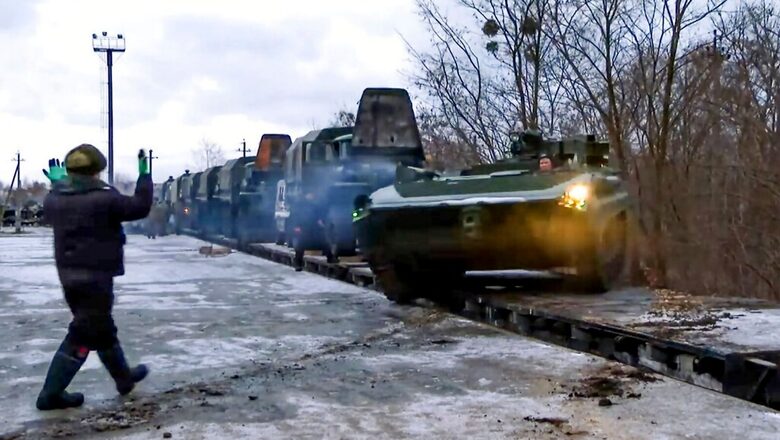
views
Tensions between Ukraine and Russia, which has massed troops along the border, have drawn Washington and Moscow into a Cold War-style stand-off. Western intelligence officials say that Russia has amassed 100,000 troops on the eastern side of the former Soviet republic. They fear another invasion by Russia, on the lines of Crimea in 2014. Numerous rounds of talks have been held between the West and Moscow, but the Russian troops remain in the area.
The tensions stemmed from Russia expressing its displeasure over Ukraine’s increasing move towards the European institutions and stating it shouldn’t join the Nato. The demand has been rejected by the Western alliance, which comprises of the United States, EU countries and Nato allies.
Here is a timeline of the spiralling situation:
Troop movements
On November 10, NATO warns Moscow about taking “aggressive action” after Washington reports unusual troops movements near the Ukrainian border.
It comes five months after Ukraine accused its larger neighbour of massing soldiers along its eastern frontier and in Crimea, which Russia annexed in 2014. Violence in the country’s east, which is also held by Russia-backed separatists since the invasion, also surges.
Russian President Vladimir Putin accuses the West of “supplying modern weapons to Kyiv” and staging provocative military exercises.
Winter offensive?
On November 28, Ukraine says Russia is massing nearly 92,000 troops for an offensive at the end of January or early February.
Moscow denies this outright and three days later accuses Kyiv of a military build-up of its own, demanding “legal guarantees” that it will never join NATO.
Virtual summit
On December 7, US President Joe Biden threatens Putin with “strong economic and other measures” during a virtual summit if he invades Ukraine. But he rules out sending troops to support Kyiv.
Putin again demands a stop to NATO’s eastward expansion as well as guarantees Ukraine will not be allowed to join.
‘Massive consequences’
On December 16, the EU and NATO warn of “massive strategic consequences if there was a further attack on Ukraine’s territorial integrity.”
The next day Moscow puts forward proposals to limit US influence on former Soviet states.
Talks to ease tensions
On December 28, Washington and Moscow announce European security talks and two days later Biden warns Putin progress depends on “de-escalation” of the Ukraine stand-off.
On January 2, 2022 Biden assures Ukraine that Washington and its allies would “respond decisively” if Russia moves to invade.
‘Real’ threat
Three days later EU foreign policy chief Josep Borrell visits the frontline in the east as he pledges the bloc’s full support for Ukraine.
On January 8, a senior White House official says the US is ready to discuss with Russia the two countries’ missile systems and military exercises.
Russia rules out any concessions, while US Secretary of State Antony Blinken warns against the risk of confrontation.
Week of diplomacy
On January 10, top US and Russian officials begin a week of tense talks in Geneva.
Two days later, NATO and Russia lay out stark differences on Ukraine at a meeting of the NATO-Russia council.
Massive cyberattack
A cyberattack on January 14 briefly knocks out key government websites in Ukraine.
Kyiv says it has uncovered clues Russia could have been behind it.
The same day US officials allege Russia has operatives in place to carry out a “false flag” operation to create a pretext to invade Ukraine. The Kremlin denies this.
Build-up in Belarus
On Monday Russian troops begin arriving in Belarus for snap military drills, which Moscow says are aimed at “thwarting external aggression”. US officials say the size of the force is “beyond what we’d expect of a normal exercise.”
The next day Washington warns that “Russia could at any point launch an attack on Ukraine.”
Meanwhile Moscow says it wants a response from the West to its demands before any more talks on the eve of a Blinken visit to Ukraine.
Despite this, NATO invites Russia to new talks.
On Wednesday Washington announces an extra $200 million in security aid to Ukraine as the threat of invasion grows.
(With inputs from AFP & AP)
Read all the Latest News here


















Comments
0 comment